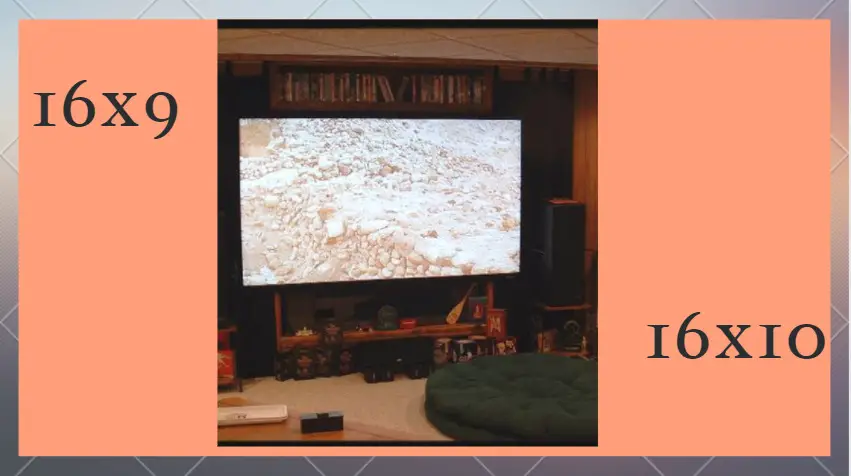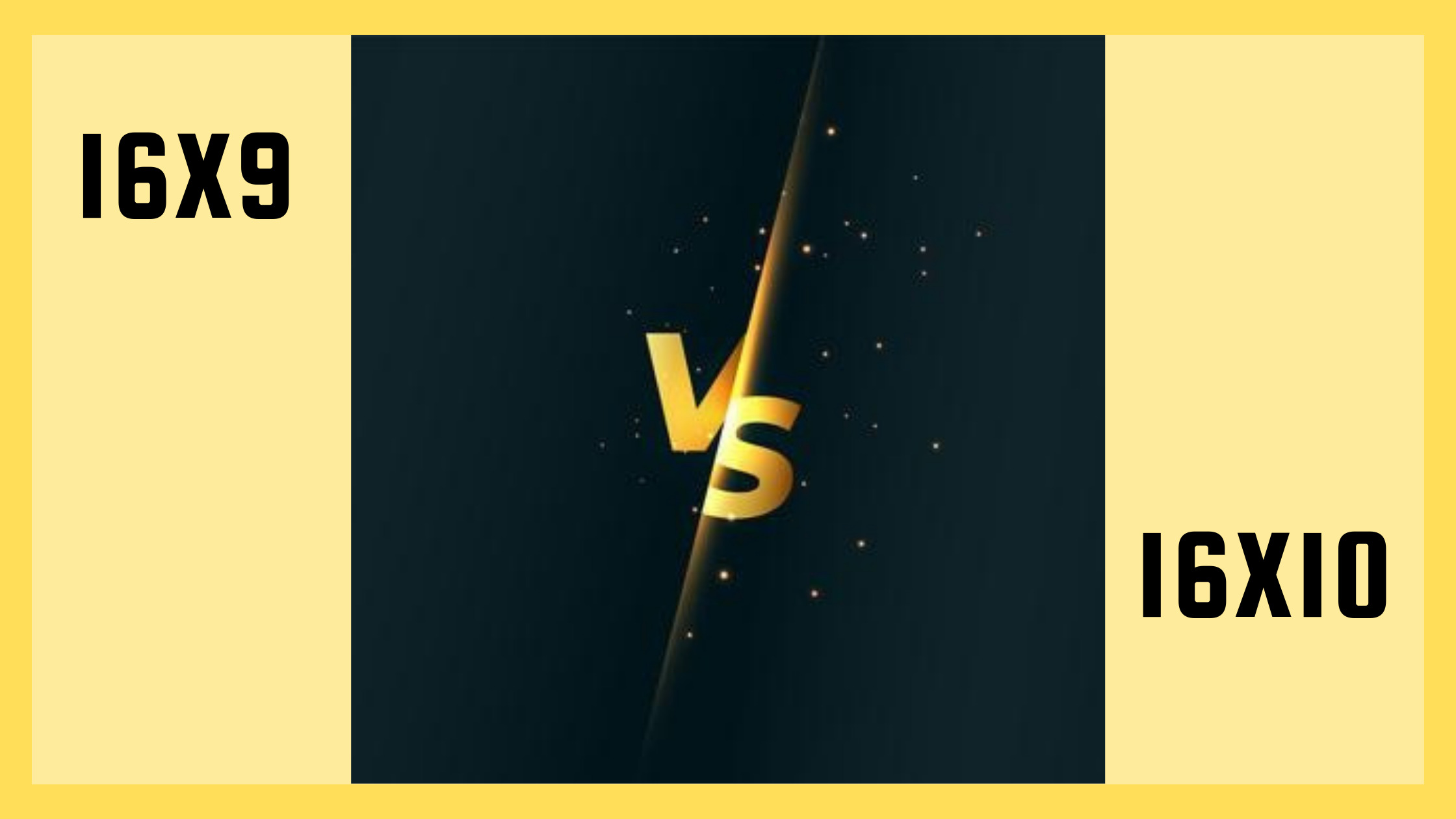| Features | 16:9 Projector Screen | 16:10 Projector Screen |
| Aspect Ratio | 16:9 | 16:10 |
| Resolution | Varies | Varies |
| Pixels | Varies | Varies |
| Screen Size | Up to 200 inches | Up to 150 inches |
| Price | Affordable to moderate | Moderate to expensive |
| Image Quality | Good | Better |
| Compatibility | Compatible with most projectors | Compatible with most projectors |
| Viewing Angle | Wide | Wide |
| Contrast Ratio | High | Higher |
| Color Accuracy | Good | Better |
| Image Sharpness | Good | Better |
| Use | Home theater, gaming | Professional, design |
Are you thinking of investing money in buying a projector screen? But afraid because you are not sure how to find the right one for your home theatre. You are not aware of the specifications of the different types of projector screens with their respective aspect ratios. This article will compare two of the most prominent 16×9 vs.16×10 projector screens and in what ways they are different.
In terms of resolution, both 16×10 and 16×9 exhibit the resolution (1200 x 800) But, in terms of horizontal dimension, contrast ratio they both differ in their pixel dimensions. One has 1366 pixels whereas the other one has 1920 pixels. That implies that those with a 16×10 projector can utilise content on either of the screen formats. While people with 16×9 will have to look for the specific kind of resolution and screen size to do the same.
Let’s discuss further in detail the difference between 16×9 vs 16×10 projector screen aspect ratios.
Overview of Projector Screen Formats and Aspect Ratios
Once you start searching for a projector screen, the first thing you need to know about is the different projector screen formats and aspect ratios. You might be wondering what the aspect ratio is? In simple terms, the video image’s difference in corresponding weight to its height relation is known as aspect ratio. You will find different kinds of aspect ratios from 4×3, 16×9 to 16×10 or the most standard one.
In this article, we will be discussing the two most used projector screen formats namely 16×9 vs. 16×10 projector screen options. You must be thinking what such numbers donates and what does it mean exactly.
Considering you have a 1:1 aspect ratio, it would not be difficult to explain that for every single unit of horizontal measurement there is a single unit of equal vertical measurement. This signifies that if you have a 4:5 aspect ratio, then possibly it means that for every 4 units of width measurement has height 5 units in measurement.
What Is Standard Projector Aspect Ratio
Well, keeping in view the most common uses of projectors for either giving presentations or watching something on a projector , be it movies or TV shows. An aspect ratio of 4×3 is reasonably considered to be fair enough because it was fulfilling the purpose of making presentations visibly good on projected screens. As time passed and technological upgradation has taken place now people have transferred from 4×3 projector screens to 16 x 9 and 16 x 10 projector screens because of its modern specifications.
However, it is commonly found that this ratio works well for most people who present using these devices due to them having enough screen space when projected onto either an external monitor or TV and not feeling too cramped compared with other viewing angles where you might situate yourself at one end.
Comparing 16×9 vs. 16×10 Projector Screens

Both 16×10 and 16×9 aspect ratios one way or another have major differences when compared. However, a content material be it a movie, a game or a documentary with an aspect ratio of 16×9 could possibly work on a screen size of 16×10 given the scenario that the image projected quality would not be as optimal as you wanted it to be. It will be a bit blurry, distorted having black bars and will not give you a cinematic feel.
That is one reason why you need to look for a suitable aspect ratio that will enable you to get a perfect resolution on the projector screen you are using. Having said that, let’s dive deep into what makes 16×10 and 16×9 projector screens different and unique from each other and in what ways.
16×9 Projector Screen – What Makes it Different?
Starting from the basics, what is a 16×9 projector screen? To be precise, High Definition (HDTV) (1:7:8:1) all belongs to this 16×9 projector screen category. This particular screen format of 16×9 is widely known to be used in the screen that are not wide in nature. You will find it in use for satellites. In the US market, 16×09 projector screen is considered to be the most ideal aspect ratio for home theatres. People who want to play games and sports using projectors could benefit from it.
The 16×9 format is not only for gaming and media rooms. It can also be used in conjunction with your television set to give you perfect visual output, whether it’s watching sports or playing video games! Not matter what type of display device that has been chosen as its input form – from projectors all the way down through TVs – this particular coding will match up perfectly so there are no compatibility issues whatsoever when using these two items together. You will be able to find a 16×9 projector for either commercial residential purposes.
The 16×9 projector screen will give you a high end performance with vibrant visual output. You will find this screen aspect ratio in most of the monitors available. Mostly, the commercial and residential projectors carry the 16×9 format and are compatible to be used with the below listed resolutions.
- Resolution of (1280 x 720) HD – 720p
- Resolution of (1920 x 1080) HD – 1080p
- High-definition (1080p HD) (1920 x 1080)
- Resolution of (3840 x 2160) UHD – Native 4K
Related: Know which is better Black projector screen vs white.
16×10 Projector Screen – What Makes it Different?
16×10 is the most hyped up projector screen aspect ratio because of its ability to display the viewing result flawlessly. It is also referred to as 8:5 and is the most commonly preferred aspect ratio to watch content in a wide screen display format. Before the wide screen gadgets were not into the mainstream market, most people would prefer to go for 16×9 as that was the standard aspect ratio considered to be used with TV and video games. It was the time back in 2008 when 16:10 surpassed the ratio of 4×3.
Now as the trend of watching content on wide screen PCs is getting so common worldwide, it has given an immense importance to the projector screen with an aspect ratio of 16:10. Not only compatible with displaying content on the computer, it is considered to be the perfect projector screen if you are using a widescreen notebook for your chosen media player. Moreover, projectors with the below mentioned specifications work best with 16×10 aspect ratio.
- Resolution of 1920 x 1200 (WUXGA)
- Resolution of 3840 x 2400 (WQUXGA)
- Resolution of 1440 x 900 (WXGA)
- Resolution of 1280 x 800 (WXGA – Native)
- Resolution of 1680 x 1050 (WSXGA)
- Resolution of 2560 x 1600 (WQXGA)
By now you can get the idea behind how 16×9 is different to 16×10 projector screen aspect ratio. To relate the 16×9 vs 16×10 projector screen, it is mandatory to know what sort of projection experience you want and the kind of media player you are using for that. Based upon your needs, you may opt for a better resolution aspect ratio to get a desirable output.
Which Projector Screen Aspect Ratio You Should Opt For – 16:9 or 19:10?
Most people get confused while choosing the aspect ratio for their projector screen. It is worth mentioning here that you can watch content meant to be displayed on a 16:19 screen on a display screen of 16:10 or on any kind of aspect ratio available to you.
Nevertheless, the issue will be of the distorted image experience because of the black sidelines appearing on the screen sides partially. When you are watching heavy content that is not in alignment with the projectors actual resolution then you will face this issue. Thereby, it is important to make sure you use the right aspect ratio needed for that content.
Now coming to the point how you can avoid those black bars on your screen to have a seamless experience without getting the projected image blurred. The answer to this is simple: get yourself a projector screen whose materials content is in alignment to the aspect ratio it needed. Therefore, you need to keep in mind the factors that are essential to remember while choosing a projector screen format.
- The video format for the content you want to project on screen
- The format of your projector
- The format of your screen (viewing surface)
Considering the above factors you can have a smooth projector experience if you meet all the required formats. In case, you are short of any of the mentioned requirements above then you will have to face black dotted bars which will affect your viewing experience negatively. Below is a video that will help you get cleared on the comparison of the aspect ratio 16×9 and 16×10.
How Do I Choose the Right Projector Screen?
When you’re picking out a projector screen, it’s important to know that 16:9 content will display without black bars on the sides or bottom of images. However if your material is not natively displayed in this format then some other distortion may occur such as blurring and scrolling issues due no match between what’s being shown and how far away from center focus point gets when projected onto certain surfaces at various angles – like paper walls! The first thing about choosing which type (or brand)of screens work best depends largely upon whether viewers plan
- Format of the projected content (the video)
- Presentation format for the projector
- Surface’s (screen’s) format
The aspect ratio of your monitor can make a world of difference in the quality and sharpness you see on screen. Do not let yourself get caught up trying to find just “the right” one; 16×9 is perfectly good if all other factors are equal, but it would be ideal for have both formats available so viewers don’t have any complaining about missing bars or whatever else might happen when only showing part raster lines (black) from images because they’re too wide/long.
Related: Alternatives of Projector Screen
Conclusion
While weighing up 16×10 vs. 16×9 projector screens, we have come to the conclusion that choosing between these two screen formats depends on viewers’ needs with respect to material and surface viewing. For instance, a user looking forward to having a cinematic gaming experience on their projector screen then the most suitable fit would be a 16×9 projector screen aspect ratio.
However, a user who is simply looking for a projector to use with their general computers or tablet with the specifications of WUXGA and WZGA along with similar intensity resolutions then he should opt for a projector screen with 16×10 aspect ratio.


